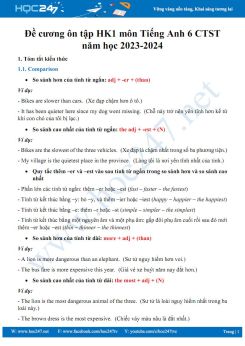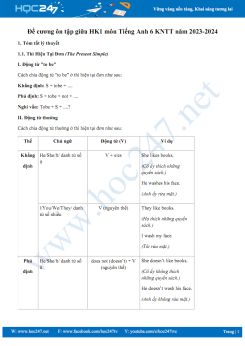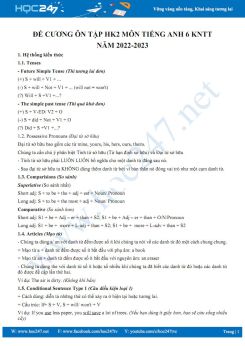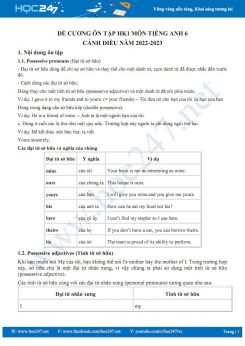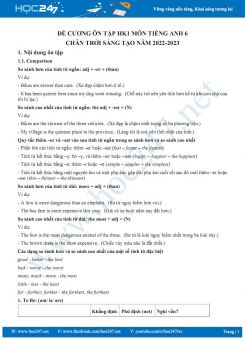HOC247 xin giới thiệu đến các em học sinh nội dung tài liệu Đề cương ôn tập HK1 môn Tiếng Anh 6 Kết nối tri thức năm học 2023-2024 bao gồm các kiến thức trọng tâm và câu hỏi ôn tập có đáp án hướng dẫn chi tiết sẽ giúp các em rèn luyện và chuẩn bị cho kỳ thi Học kì 1 sắp tới. Chúc các em đạt được kết quả học tập tốt!
1. Tóm tắt kiến thức
1.1. The present simple (Thì Hiện tại đơn)
Thì hiện tại đơn (Simple present or Present simple) là một thì diễn tả một hành động chung chung, tổng quát lặp đi lặp lại nhiều lần hoặc một sự thật hiển nhiên hoặc một hành động diễn ra trong thời gian hiện tại.
- Cách dùng thì hiện tại đơn
- Diễn đạt một thói quen hoặc hành động lặp đi lặp lại trong hiện tại
- Chân lý, sự thật hiển nhiên
- Sự việc xảy ra trong tương lai. Cách này thường áp dụng để nói về thời gian biểu, chương trình hoặc kế hoạch đã được cố định theo thời gian biểu.
- Sử dụng trong câu điều kiện loại 1.
- Sử dụng trong một số cấu trúc khác
- Form
|
Thể |
Động từ “tobe” |
Động từ “thường” |
|
Khẳng định |
S + am/are/is |
S + V(e/es) |
|
Phủ định |
S + am/are/is + not + ... Note : is not = isn’t ; are not = aren’t |
S + do/ does + not + V(ng.thể) Note : do not = don’t does not = doesn’t |
|
Nghi vấn |
Yes – No question Am/ Are/ Is (not) + S + ….? Yes, S+ am/ is/ are No, S+ am/is/are +not. Wh- questions Wh + am/ are/ is (not) + S + …? |
Yes – No question Do/ Does (not) + S + V(ng.thể)..? Yes, S + do/ does. No, S + don’t/ doesn’t. Wh- questions Wh + do/ does(not) + S + V(nguyên thể)….? |
- Dấu hiệu nhận biết thì hiện tại đơn
+ Always (luôn luôn) , usually (thường xuyên), often (thường xuyên), frequently (thường xuyên) , sometimes (thỉnh thoảng), seldom (hiếm khi), rarely (hiếm khi), hardly (hiếm khi) , never (không bao giờ), generally (nhìn chung), regularly (thường xuyên).
+ Every day, every week, every month, every year,... (Mỗi ngày, mỗi tuần, mỗi tháng, mỗi năm)
+ Once/ twice/ three times/ four times….. a day/ week/ month/ year,... (một lần / hai lần/ ba lần/ bốn lần/ một ngày/ tuần/ tháng/ năm)
1.2. The present continuous (Thì Hiện tại tiếp diễn)
- Công thức:
Khẳng định: S + am/ is/ are + V_ing + O
Phủ định: S + am/ is/ are+ not + V_ing + O
Nghi vấn: Am/Is/Are + S + V_ing+ O?
- Dấu hiệu nhận biết thì hiện tại tiếp diễn:
+ At present, at the moment, now, right now, at, look, listen.…
- Cách dùng:
+ Diễn tả hành động đang diễn ra và kéo dài trong hiện tại.
Ex: She is going to school at the moment.
+ Dùng để đề nghị, cảnh báo, mệnh lệnh.
Ex: Be quiet! The baby is sleeping in the bedroom.
+ Dùng để diễn tả một hành động sắp xảy ra trong tương lai theo kế hoạch đã định trước
Ex: I am flying to Moscow tomorrow.
+ Diễn tả sự không hài lòng hoặc phàn nàn về việc gì đó khi trong câu có “always”.
Ex: She is always coming late.
Note: Không dùng thì hiện tại tiếp diễn với các động từ chỉ tri giác, nhận thức như : to be, see, hear,feel, realize, seem, remember, forget, understand, know, like , want , glance, think, smell, love, hate…
Ex: He wants to go for a cinema at the moment.
1.3. Prepositions of place (Giới từ chỉ địa điểm)
In: Inside
At: used to show an exact position or particular place
On:
+ next to or along the side of (river)
+ used to show that something is in a position above something else and touching it.
+ left, right
+ a floor in a house
+ used for showing some methods of traveling
+ television, radio
By, next to, beside, near: not far away in distance
Between: in or into the space which separates two places, people or objects
Behind: at the back (of)
In front of: further forward than someone or something else
Under: lower than (or covered by) something else
1.4. Comparative (So sánh hơn)
a. Tính từ ngắn: Tính từ có 1 âm tiết, hoặc 2 âm tiết nhưng chữ cái cuối cùng của âm tiết thứ hai có kết thúc là –y, –le,–ow, –er, và –et được cho là tính từ ngắn.
Ex: Short – /ʃɔːrt/: ngắn Sweet – /swiːt/: ngọt Clever –khéo léo, khôn khéo
b. Tính từ dài: Những tính từ có từ ba âm tiết trở lên được gọi là tính từ dài.
Ex: Beautiful /: đẹp Intelligent – thông minh
Expensive –/: đắt đỏ
c. Công thức
Short Adj: S + V + adj + er + than + N/pronoun
Long Adj: S + V + more + adj + than + N/pronoun
Ex: She is taller than I/me
- This book is more intelligent than that one.
Dạng khác: S + V + less + adj + than + N/pronoun (ít hơn)
1.5. Cấu trúc với Must (Phải, cần phải), Should (Nên)
1.5.1. Must
- Must được dùng để đưa ra một lời khuyên, hoặc một đề nghị được nhấn mạnh.
- Thể khẳng định: S + must + verb (inf. without to)
- Thể phủ định: S + must not/ mustn’t + Vinf. [viết tắt: must not = mustn’t]
- Thể nghi vấn: Must + S + verb…?
1.5.2. Should
- Diễn tả một lời khuyên, một việc tốt nên thực hiện.
- Dùng để hỏi, xin ý kiến, nêu ý kiến về một vấn đề gì đó.
- Diễn tả một điều gì đó không đúng, hoặc không như mong đợi.
- Diễn tả một suy đoán, hoặc kết luận một điều gì đó có thể xảy ra trong tương lai.
- Thể khẳng định: S + should + verb (inf. without to)
- Thể phủ định: S + should not/ shouldn't + Vinf. [viết tắt: should not = shouldn't]
- Thể nghi vấn: Should + S + verb…?
2. Trắc nghiệm ôn tập
A. Choose the word whose underlined part is pronounced differently from the others.
|
1. a. should |
b. around |
c. house |
d. sound |
|
2. a. Shout |
b. flower |
c. bow |
d. throw |
|
3. a. sure |
b. shout |
c. sing |
d. wish |
|
4. a. peach |
b. sweets |
c. eat |
d. feather |
|
5. a. celebrate |
b. cousin |
c. city |
d. cinema |
B. Choose the best option (A, B or C) to each space.
1. How is your first week _________ school?
A. on
B. at
C. for
D. to
2. My brother often helps me_________ my homework.
A. at
B. about
C. for
D. with
3. Megan is_________ badminton with her friends in the schoolyard.
A. having
B. studying
C. playing
D. doing
4. The villa is_________ by pine trees.
A. surrounded
B. built
C. covered
D. grounded
5. We do_________ in the gym every afternoon.
A. table tennis
B. football
C. judo
D. homework
6. My kids spend hours chatting ______ the phone ______ their friends.
A. at - with
B. on - to
C.to - with
D. in - about
7. Could you turn the television ______? I want to watch the news.
A. on
B. off
C. down
D. up
8. My best friend ______ a round face and big eyes.
A. have
B. has
C.is
D. gets
9. My brother is really ______. He always does his homework.
A. hard-working
B. serious
C. confident
D. patient
10. When eating, most Vietnamese people hold chopsticks in their right ______.
A. arm
B. leg
C. finger
D. hand
C. Put the verbs in brackets in the correct tense form.
1. He (drive) _______________to the office every day.
2. she (learn) _______________ English now?
3. Be quiet! We (study) _______________in the library.
4. At break time, I (go) _______________to the library and (read) some books.
5. you (like) _______________ this film?
6. Sit down! A strange dog_______________ (run) to you.
7. My mom often (buy) _______________meat from the butcher's.
8. My brothers (not/ drink) _______________coffee at the moment.
9. Look! Those people (climb) _______________the mountain so fast.
10. That girl (cry) _______________loudly in the party now.
D. Fill in the blank, using There is or There are.
1._____________ a big bottle on the table.
2.____________ many chairs in the living – room.
3. ____________ four cats and a dog in my house.
4. ____________ a lot of flowers in the garden.
5. ____________ an ice – cream in the fridge.
E. Rearrange the words to make complete sentences.
1. secondary/ first/ your/ at/ school/ is/ how/ week?
………………………………………………………………
2. art/ creative/ are/ drawings/ students/ the/ some/ doing/ in/ club
………………………………………………………………
3. school/ at/ English/ we/ have/ classes/ don’t/ today
………………………………………………………………
4. is/ the/ clock/ The/ on/ wall.
………………………………………………………………
5. doing/ This/ homework./ are/ we/ evening,/ our/
………………………………………………………………
F. Read the e-mails from Vy and answer the questions.
Hi Tom, How are you? Now I’ll tell you about my bedroom. My bedroom is small. I have a bed, a wardrobe, a table, a chair and a lamp. I like music, so I put three posters of famous singers on the wall. I usually do my homework on the desk in front of the big window. My room is my favourite room in the house. It’s comfortable. What is your favourite room, Tom? Write to me soon.
Best,
Vy.
1. Is Vy’s bedroom big or small?
2. What is there in Vy’s bedroom?
3. Where does she put three posters of famous singers?
4. Why does she like her bedroom?
Trên đây là một phần trích đoạn nội dung Đề cương ôn tập HK1 môn Tiếng Anh 6 KNTT năm học 2023-2024. Để xem toàn bộ nội dung các em chọn chức năng xem online hoặc đăng nhập vào trang hoc247.net để tải tài liệu về máy tính.
Mời các em tham khảo tài liệu có liên quan:
- Đề cương ôn tập HK1 môn Tin học 6 KNTT năm 2023 -–2024
- Đề cương ôn tập HK1 môn Lịch sử và Địa lí 6 KNTT năm 2023-2024
Hy vọng tài liệu này sẽ giúp các em học sinh ôn tập tốt và đạt thành tích cao trong học tập.






